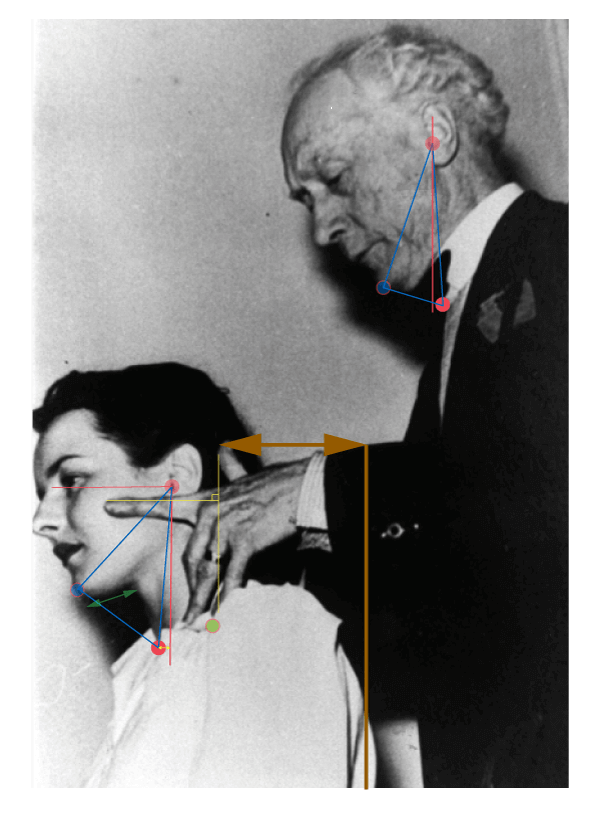“The specific control of a finger, of the neck, or of the legs should primarily be the result of the conscious guidance and control of the mechanism of the torso, particularly of the antagonistic muscular actions which bring about those correct and greater co-ordinations intended to control the movements of the limbs, neck, respiratory mechanism, and the general activity of the internal organs”. [emphasis added] (Alexander, F.M., msi, The Processes of Conscious Guidance and Control, p. 126)
“What this young lady is doing now is a very difficult thing to do. She is directing her head forward and up from here (Alexander indicates with his hands a part of her back), he knees forward and the hips back, and that the only way you can get your antagonistic pulls.
What interest me is to give her something to do by means of which she will put this head forward, and the knees forward and the hips back, and so to get the antagonistic pulls working… ” (Bedford Lecture, Alexander, F.M., J.O. Fisher, “Articles and Lectures”, p. 177).
As you all know, I do not teach with manipulations because I am interested into what a pupil can learn and experiment for himself in order to develop his conscious guidance and control. Yet, I analyzed every single photograph where the founder is seen working with his hands. You cannot imagine how grateful I am for these photos. To me they are evidence of a clear geometrical guidance and they also represent a geometrical determination of the end result; on this particular image, Alexander is directing the student’s head forward and up from the middle of the torso—and his own head does not seem as precisely directed forward (he is slightly depressing the larynx).
Coming back to my area of interest, this positive and geometric determination of the end result is perfect to set up an experiment. If the first quote is correct, if Alexander is right, then the freedom of the neck obtained as a result of the conscious guidance and control of the mechanism of the torso should lead to a new condition of the use of the self in which the head should go forward and up relatively to the center of the back. It would all be an inevitable consequence of a new guidance of the mechanism of the torso. Therefore, it could be possible to experiment with the conscious guidance of the mechanism of the torso and control the result through its effect on the head position relatively to the torso.
If I took the man to his word, the last thing I would do would be to instruct my pupil to do anything to change the position of the head. I would eradicate from his mind the idea of wishing it somewhere, of pulling it somewhere; I would evacuate the whole problem of the head from his mind and will, leading him to think about everything else in the use of the joints in the anatomical structure but for the neck—and, believe me, there is a lot to think about in a connected way in the mechanism of the torso.
Then I would possess a great means whereby judging if the man was writing the truth, at least in the central core of his early technique: could a student —could he— consciously direct himself to do something by means of which to obtain such an end result? Instructing my students in the use of the antagonist actions in the articulated mechanism of the torso, I would wait to see where the head would go, where it is impossible for it to go without the right conditions.
I would test his word.
I did.
The man’s name is Frederick Matthias Alexander. He left four books and a few photographs behind him. And us.
The iAt is an experiment to replicate the path of discovery that led Alexander to change his use of the self as a whole without any sensory guidance, without any form of external manipulations. I therefore do not concern myself with how to teach students to put hands on people, but with the means whereby any student can self-experiment with conscious guidance and control to self-regulate his/her own use. As you can see, all ends that we strive to attain with reasoned and connected instructions (means-whereby) are calculated with Delsarte’s geometrical movement coding system and it is astonishing how easily Alexander’s photos of manipulations can be fitted in this scheme as if he knew all along about it and did not just employ them to direct the use of his students.
This post is 800 words. I wanted to publish this breadcrumb of a text to show my mentors that I am able to communicate with short sentences and concise ideas. Unfortunately this will not hide the next post coming this week which IS NOT, I must admit, a great success in this respect (currently 78,000 words). I think I will cut it in two parts. To my defence, the subject is worth it…


I like this approach because it seems to follow what Alexander did himself and us in tune with his writings.i also am attracted to it involving specifics rather than vague generalisations.